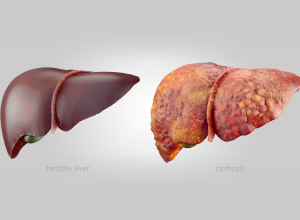
Cirrhosis
Cirrhosis is an irreversible scarring of the liver that appears after continuous damage to the organ. It’s usually caused by heavy consumption of alcohol or hepatitis C.
Symptoms
Cirrhosis usually shows very few signs and symptoms during its early stages, but as the disease progresses, it shows itself first via loss of appetite, nausea, and itchy skin, and then via jaundice, tarry-looking stools, blood-filled vomit and swelling in the legs (called edema).
Treatment and Prevention
Currently, there is no cure for cirrhosis, but the disease can be managed to reduce symptoms and slow its progression. Typical treatments include reduction of alcoholic beverages if that is the cause, or using anti-viral medication if something like hepatitis C or hepatitis B is the cause. Advanced cases of cirrhosis can cause liver failure, so a liver transplant may be a person’s only treatment option.
Cirrhosis can be prevented by not exceeding the daily recommended limits for alcohol consumption and avoiding contracting hepatitis C (which is spread through unprotected sex and dirty drug/tattoo needles).
Notice concerning medical entries:
Articles having medical content shall serve exclusively for the purpose of general information. Such articles are not suitable for any (self-) diagnosis and treatment of individual illnesses and medical indications. In particular, they cannot substitute for the examination, advice, or treatment by a licensed physician or pharmacist. No replies to any individual questions shall be effected through the articles.






